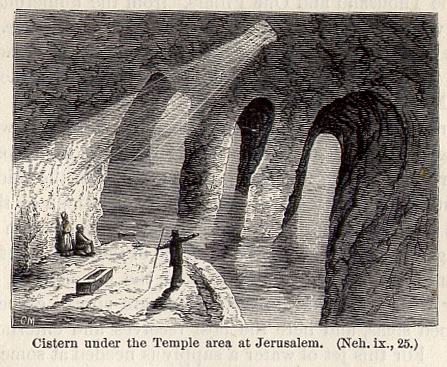
Van-Lennep’s illustration of a Easterner with outstretched arm in awe at the scenes under the Temple mount at Jerusalem
Heny J. Van-Lennep, missionary, author and artist of the Holy land, has no doubt that the “remarkable reproduction of Biblical life in the East of our day is an unanswerable argument for the authenticity of the sacred writings.†While the bias of this Christian writer is clear, it would appear to flow more from a sense of sectarian and cultural superiority rather than an innate desire to denigrate the people being studied. Because writers like Van-Lennep believed that current customs of the Arabs, in particular, had been preserved by God as a testimony to the truth of scripture, these customs were held in high regard. While I hesitate to label the efforts of these texts as “ethnography†in the contemporary sense, Van-Lennep (1875:6) is proud of the fact that he “enjoyed unrivaled opportunities of intercourse with all classes of people.â€
Rather than using his text to criticize the “Orientals,†Van-Lennep (1875:7) is at pains to counter existing stereotypes of his day. Thus, he used “Mohammed†rather than “Mahometâ€, “Bedawy†rather than “Bedouin.†Consider the rationale for recognizing how Muslims saw themselves: “On the other hand, we have not called the religion of Mohammed Mohammedanism, but Islam, its universal name in the East (not Islamism, nor the religion of Islam); and his followers not Mohammedans, but, as they call themselves, Muslims (not Mussulmans); Muslimin is the plural of Muslim.†To the extent that Van-Lennep believed that God had preserved these customs as a testimony, it was important to describe them as accurately as he could.
Here is how he introduces his tome. Note the desire to describe contemporary customs faithfully and the awareness of bias in previous accounts.
“How important, then, to the Biblical scholar is the study of the modern East, not only of its antiquities, intensely interesting as they are, but of the manners and customs of its present inhabitants! The remarkable reproduction of Biblical life in the East of our day is an unanswerable argument for the authenticity of the sacred writings; they could not have been written in any other country, nor by any other people than Orientals. As a French writer [Léon Paul, 110] justly remarks: ‘These customs, so unchanged; these manners, which have remained the same through the lapse of eighteen centuries, impart strength and vividness to our faith.’ The minute and literal correctness of the foregoing testimonies will appear as we proceed in the present work, whose object is to throw such light as can be derived from the manners and customs of the modern inhabitants of Bible lands upon the social, religious, and political life of Bible times. Our subject is not entirely new; many things have been mentioned by travelers and Orientalists. Some of these, however, were ignorant of the languages of the country they visited, and therefore unable to hold any intercourse with the people. Others only followed the beaten lines of travel, and therefore saw only the worst phases of human nature. Some visited but a small part of the field, though perhaps the most important; their views and statements are apt to be one-sided and sweeping. Others have failed to get at the homes of the people, have learned things only by hearsay, or have viewed every object through the lens of prejudice, sometimes too favorable, but oftener unjust. We make no claim to immunity from fault, but having spent almost a lifetime in the East, and enjoyed unrivaled opportunities of intercourse with all classes of the people, we have no such excuse to pleas if we fail to furnish our readers with reliable and comprehensive information upon the topic of our choice.
Let it not be supposed, however, that our object is the mere gratification of a laudable curiosity respecting the interesting countries which have been the scene of Biblical history. We believe the customs of the modern East to be the only key that can unlock the sense of many a valuable text of Scripture and bring it to view.â€
Henry J. Van-Lennep, Bible Lands: Their Modern Customs and Manners Illustrative of Scripture (New York: Harper and Brothers, 1875), pp. 6-7.
For #1 in this series, click here.